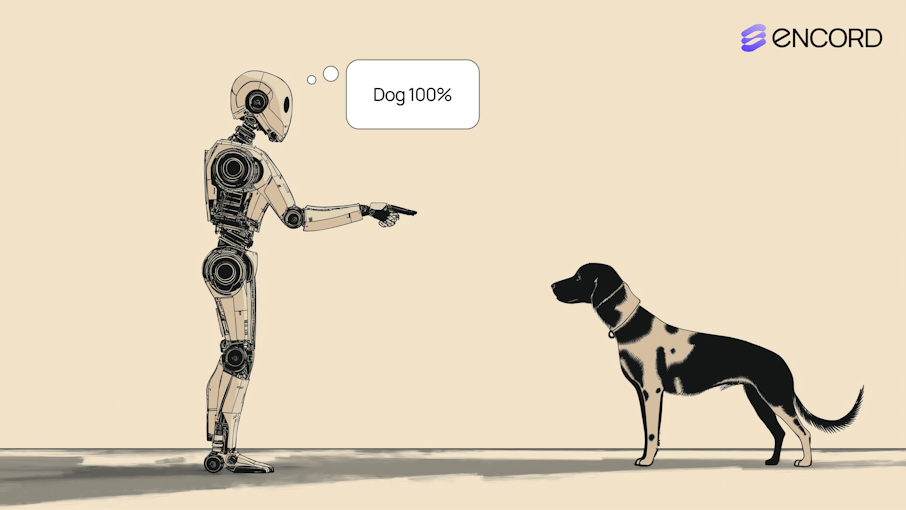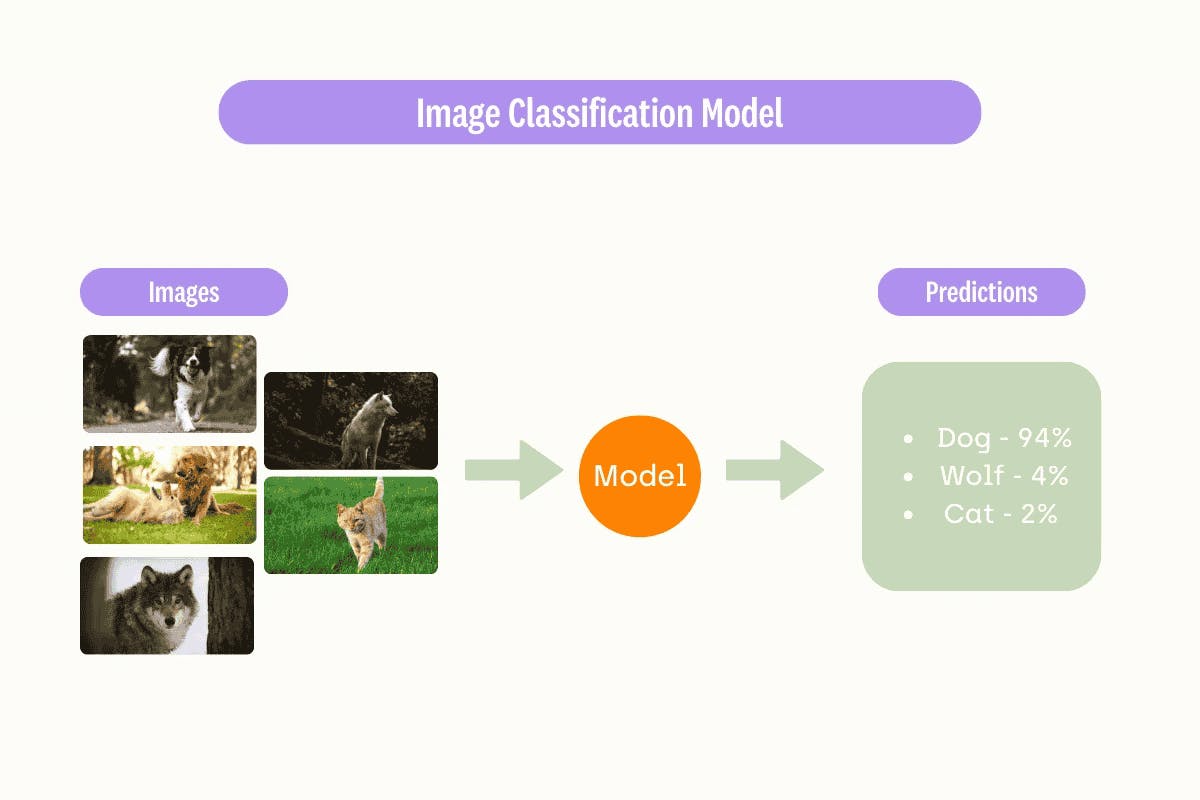Contents
What is Image Classification?
How Image Classification Works
Common Challenges and Solutions
Real-World Applications and Use Cases
Best Practices for Image Classification
Future Trends in Image Classification
Key Takeaways: Machine Learning Image Classification
Encord Blog
Machine Learning Image Classification: A Comprehensive Guide for 2025
5 min read

Imagine a security system that instantly identifies potential threats, much like the advanced surveillance depicted in science fiction. This capability is now a reality, thanks to image classification—a fundamental element of computer vision that enables machines to interpret and categorize visual data accurately.
At its core, image classification processes images as pixel arrays, using sophisticated algorithms to extract meaningful features and assign them to predefined categories. It has transformed numerous industries, from retail and agriculture to healthcare and autonomous driving.
Image classification has become a key driver of modern AI systems, with the global image recognition market reaching $43.60 billion in 2023 and projected to hit $178.13 billion by 2032. The technology has evolved from simple object detection to sophisticated visual analysis systems that can process complex patterns and make nuanced distinctions across multiple industries.
This article provides a comprehensive guide to image classification in 2024, covering its principles, current methodologies, and practical applications across various industries. We will cover the latest advancements, challenges, and best practices in implementing image classification solutions.
What is Image Classification?
Image classification is a fundamental computer vision task that assigns predefined labels or categories to entire images based on their visual content. At its core, the process involves analyzing pixel-level data through mathematical models to identify patterns and features that distinguish different classes of images.
Image classification systems employ different approaches based on the labeling task's complexity and the application's specific requirements. Understanding these distinctions is crucial for implementing effective classification solutions.
The following table comprehensively compares the three main types of image classification approaches, highlighting their key characteristics, applications, and technical implementations.
| Characteristic | Binary Classification | Multiclass Classification | Multilabel Classification |
| Number of Classes | 2 classes | 3 or more classes | Multiple non-exclusive classes |
| Label Assignment | One label per image | One label per image | Zero or more labels per image |
| Decision Making | Single decision boundary | One-vs-all or one-vs-one | Independent probability per label |
| Common Use Cases | Medical diagnosis (disease/no disease), Quality control (defect/no defect), Email spam detection | Animal species classification, Handwritten digit recognition, Email type categorization | Scene understanding, Auto-tagging documents, Color identification in images |
| Popular Algorithms | Logistic Regression, Support Vector Machines, Decision Trees | Random Forests, Neural Networks, SVMs with multiple boundaries | Adapted SVMs, Neural Networks, Decision Trees |
| Evaluation Metrics | True/False Positives, True/False Negatives | Confusion Matrix, Accuracy per class | Hamming Loss, Per-label metrics |
Table 1: Comparative Analysis of Image Classification Types and Their Implementation Characteristics
How Image Classification Works
Image classification transforms raw visual data into meaningful categorical outputs through a systematic pipeline of preprocessing, feature extraction, and model training. Modern approaches primarily utilize deep learning techniques, particularly Convolutional Neural Networks (CNNs), to achieve state-of-the-art results.

Figure: How a vanilla image classification model works (Source)
Pre-processing and Data Preparation
The foundation of successful image classification lies in proper data preparation. This involves:
def preprocess_image(image):
# Resize to standard dimensions
image = cv2.resize(image, (224, 224))
# Normalize pixel values
image = image.astype(np.float32) / 255.0
# Apply data augmentation
image = apply_augmentation(image,
transforms=['rotation', 'flip', 'brightness'])
return imageData preparation includes noise reduction, contrast enhancement, and resizing to ensure uniform input dimensions. Consistency in brightness and color correction across the dataset is crucial for model performance.
Feature Extraction Methods
Modern feature extraction relies on deep learning architectures that automatically learn hierarchical representations:
class FeatureExtractor(nn.Module):
def __init__(self):
super().__init__()
self.conv1 = nn.Conv2d(3, 64, kernel_size=3)
self.pool = nn.MaxPool2d(2, 2)
self.fc = nn.Linear(64 * 111 * 111, 512)
def forward(self, x):
x = self.pool(F.relu(self.conv1(x)))
x = x.view(-1, 64 * 111 * 111)
return self.fc(x)Feature extraction identifies distinct elements within images, reducing dimensionality while preserving essential information. Edge detection and corner detection serve as fundamental techniques for enhancing feature quality.
Pseudocode for Image Classification Workflow
The following pseudocode outlines a typical image classification workflow:
1. Load and preprocess the dataset: a. Resize images to uniform dimensions. b. Normalize pixel values. c. Augment data (e.g., rotations, flips). 2. Split the dataset: a. Training set b. Validation set c. Test set 3. Define the model architecture: a. Choose between CNN or ViT. b. Specify layers and parameters. 4. Compile the model: a. Select loss function (e.g., cross-entropy). b. Choose an optimizer (e.g., Adam). c. Define evaluation metrics (e.g., accuracy). 5. Train the model: a. Input training data. b. Validate using the validation set. c. Adjust parameters to minimize loss. 6. Evaluate the model: a. Test on the test set. b. Calculate evaluation metrics (accuracy, precision, recall, F1 score). 7. Fine-tune the model: a. Adjust hyperparameters as needed. b. Retrain and re-evaluate. 8. Deploy the model for inference.
Model Evaluation Metrics
Evaluating the performance of image classification models requires appropriate metrics:

Key concept: The choice of evaluation metrics should align with specific business objectives and the nature of the classification problem.
Common Challenges and Solutions
Data Quality and Quantity Issues
High-quality, diverse datasets are essential for training robust models. Insufficient or biased data can lead to poor generalization. To mitigate this, data augmentation techniques—such as rotations, flips, and color adjustments—are employed to artificially expand the dataset artificially, enhancing model robustness.
Additionally, transfer learning allows models pre-trained on large datasets to be fine-tuned on smaller, domain-specific datasets, improving performance with limited data.
Lighting and Environmental Variations
Variations in lighting and environmental conditions can significantly affect image appearance, posing challenges for consistent classification.
| Variation Type | Impact | Solution Approach |
| Illumination | Changes in shadows and contrast | Data augmentation with brightness variations |
| Scale | Object size differences | Multi-scale training techniques |
| Viewpoint | Angle-dependent features | Rotation and perspective augmentation |
| Background Clutter | Interference from surroundings | Background removal preprocessing |
Moreover, advanced preprocessing techniques, like histogram equalization, can normalize lighting differences, aiding in consistent feature extraction.
Model Complexity vs. Performance
Balancing model complexity and performance is crucial. Overly complex models may overfit, capturing noise instead of relevant patterns, while overly simplistic models might underfit, failing to learn important features.
Regularization techniques, such as dropout and weight decay, help prevent overfitting by penalizing excessive complexity. Cross-validation is also employed to ensure models generalize well to unseen data.
The trade-off between model complexity and performance requires careful consideration:
- Simpler algorithms like SVMs work well for limited datasets
- CNNs excel with complex patterns but demand more resources
- Transfer learning offers a balance between performance and training efficiency
Processing Resource Requirements
Deep learning models, especially large convolutional neural networks, demand substantial computational resources, which can be a constraint. To address this, model optimization techniques like pruning and quantization reduce model size and computational load without significantly compromising performance.
Additionally, leveraging cloud-based platforms and specialized hardware accelerators, such as GPUs and TPUs, can efficiently provide the necessary computational power.
Real-World Applications and Use Cases
Image classification has transformed numerous industries by enabling automated visual analysis and decision-making. Here's how different sectors leverage this technology:
Medical Imaging and Diagnostics
Medical professionals use advanced image classification to achieve 91.4% accuracy in brain tumor detection and 90% in pulmonary nodule identification.
These systems analyze medical images like X-rays, MRIs, and CT scans to assist in early disease detection and diagnosis, significantly reducing the burden on radiologists who must interpret one image every 3-4 seconds to meet clinical demands.
Manufacturing Quality Control
Image classification has revolutionized manufacturing quality control, delivering measurable improvements in productivity and accuracy. After implementing AI-based image classification in their electronics manufacturing facilities, Siemens reported a 90% reduction in false positives and a 50% increase in defect detection accuracy.
Security and Surveillance
Security and surveillance systems have evolved significantly through AI and computer vision capabilities. Modern surveillance systems can detect anomalies, recognize faces, and track objects in real time, providing enhanced security monitoring and threat prevention.
Retail and E-commerce
In retail and e-commerce, AI-powered solutions are driving significant business value. Retailers like Nike use AI algorithms to optimize inventory management and predict consumer demand patterns.
Personalized recommendation systems, powered by AI, can increase revenues by up to 15%, with personalized suggestions accounting for up to 30% of e-commerce site revenues—companies like Zara leverage real-time AI analysis of customer interactions to dynamically adjust product recommendations.
Best Practices for Image Classification
Data Preparation Guidelines
Effective data preparation is crucial for high-performing image classification models. Key practices include:
- Data Cleaning: Remove duplicates, correct mislabeled data, and handle missing values to ensure data quality.
- Data Augmentation: Apply rotation, scaling, and flipping techniques to increase dataset diversity and improve model generalization.
- Normalization: Standardize pixel values to a consistent range, typically [0, 1] or [-1, 1], to facilitate faster and more stable training.
- Balanced Datasets: Ensure class distributions are even to prevent model bias towards dominant classes.
Model Selection Considerations
Choosing the right model architecture significantly impacts classification performance. Consider the following:
- Architecture Complexity: Balance between model complexity and computational resources. Complex models like ResNet or EfficientNet often achieve higher accuracy but require more resources.
- Transfer Learning: Utilize pre-trained models on large datasets and fine-tune them for specific tasks to reduce training time and improve accuracy.
- Scalability: Select models that can scale with increasing data sizes and adapt to evolving requirements.
- Evaluation Metrics: Use appropriate metrics such as accuracy, precision, recall, and F1-score to assess model performance comprehensively.
Future Trends in Image Classification
Emerging Technologies and Techniques
Advancements in technology are continuously enhancing image classification capabilities:
- Self-Supervised Learning: Enables models to learn representations from unlabeled data, reducing the reliance on large labeled datasets.
- Attention Mechanisms: Improve model focus on relevant image regions, enhancing classification accuracy.
- Edge AI: Deploying models on edge devices allows real-time image classification with low latency and reduced bandwidth usage.
- Explainable AI (XAI): Provides insights into model decision-making processes, fostering trust and facilitating debugging.
Evolving Trends
The future of image classification is poised for significant progress:
- Integration with Multimodal Data: Combining image data with other modalities like text and audio to create more robust and context-aware models.
- Automated Machine Learning (AutoML): Streamlines the model development process by automating architecture search and hyperparameter tuning.
- Quantum Computing: Although in its early stages, quantum computing holds the potential for solving complex classification tasks more efficiently. There are various use cases for quantum computing already being explored in fields like cryptography, machine learning, and optimization.
- Continuous Learning: Developing models that can learn and adapt in real-time without forgetting previously acquired knowledge.
Integration with Other AI Technologies
Combining image classification with other AI technologies can unlock new applications:
- Natural Language Processing (NLP): Integrating visual and textual information enhances tasks like image captioning and visual question answering.
- Robotics: Improves object recognition and navigation capabilities in autonomous systems and intelligent robots.
- Augmented Reality (AR) and Virtual Reality (VR): Enables interactive and immersive experiences by accurately recognizing and classifying virtual and real-world objects.
- Healthcare: Facilitates diagnostic imaging analysis by integrating classification models with electronic health records and other patient data.
By adhering to best practices in data preparation and model selection, engineers can advance the field of image classification, enabling more accurate and efficient AI-driven solutions.
Key Takeaways: Machine Learning Image Classification
Mastering data preparation and model selection lays a strong foundation for effective image classification. Embracing emerging technologies and anticipating future advancements will drive innovation and enhance model capabilities. Integrating image classification with other AI technologies will unlock diverse applications, advancing AI-driven solutions across various industries.
Explore the platform
Data infrastructure for multimodal AI
Explore product
Explore our products


